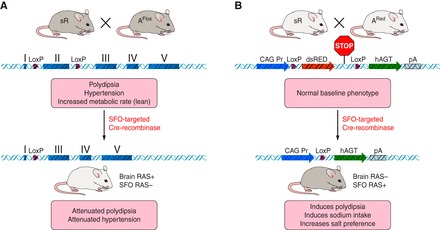Fig. 2.

Schematic of mouse models. The figure schematically illustrates the sRAFlox and sRARed models described in the text. Brain-specific production of ANG II occurs in the double transgenic sRAFlox mice in and around cells expressing human renin under the control of a neuron-specific promoter and human angiotensinogen under the control of its own promoter (which is active in glial cells and certain neurons). These mice exhibit robust polydipsia, hypertension, and elevated resting metabolic rate. Expression of human angiotensinogen can be ablated in response to cre-recombinase. This cell-specific ablation can occur by breeding with an appropriate cre-driver or by injection of a virus expressing cre-recombinase. After SFO-targeted delivery of Cre-recombinase, the sRAFlox mice exhibited attenuated drinking and blood pressure. As an alternative, production of ANG II will only occur in response to cre-mediated recombination in the sRARED mouse model. This is because production of human angiotensinogen is blocked by a “STOP” signal that can be removed by cre-recombinase. Thus sRARED mice exhibit no changes in phenotype in the absence of a cre-driver. After SFO-targeted delivery of Cre-recombinase, the sRARED mice exhibited increased water and sodium intake and increased salt preference.
